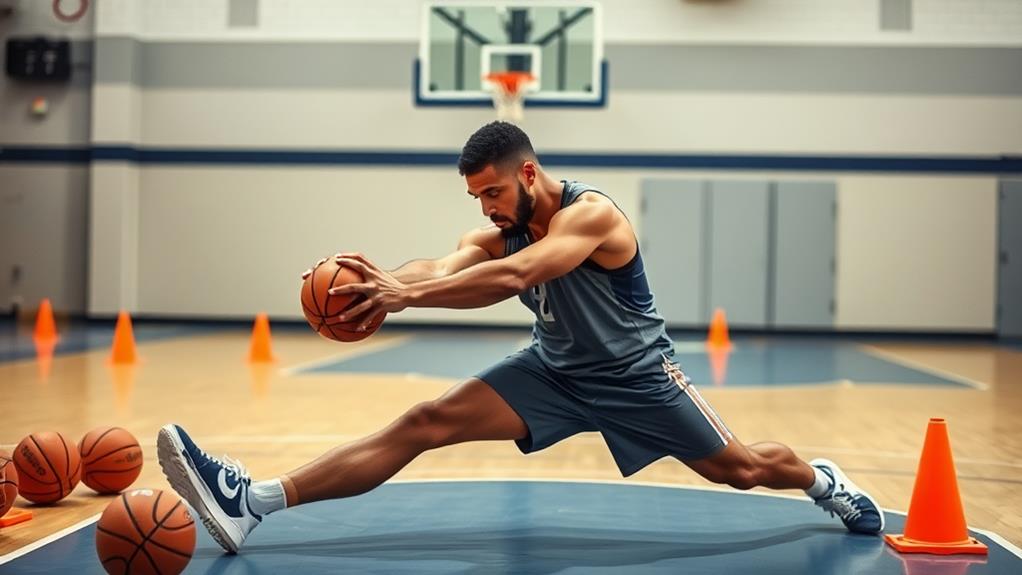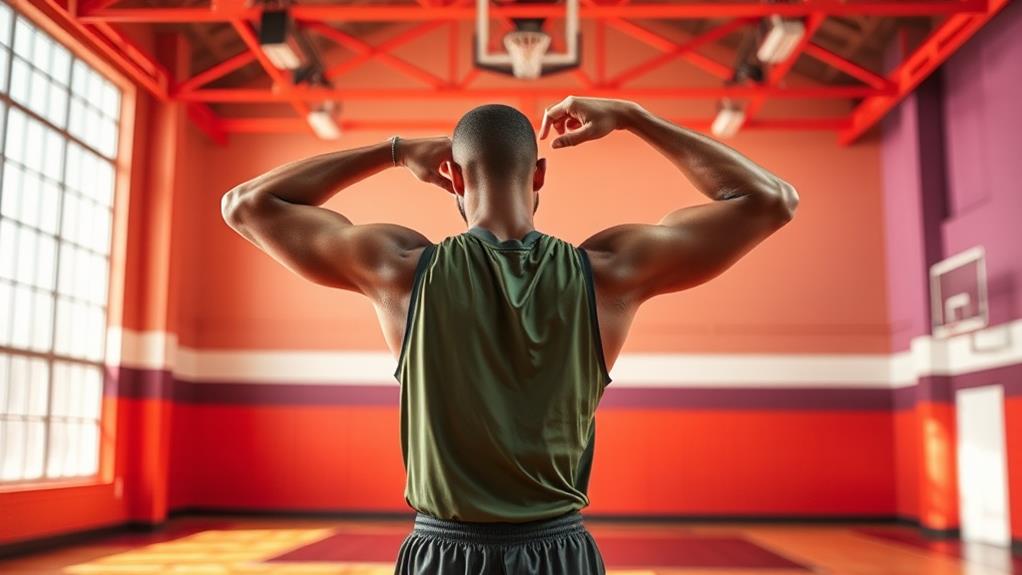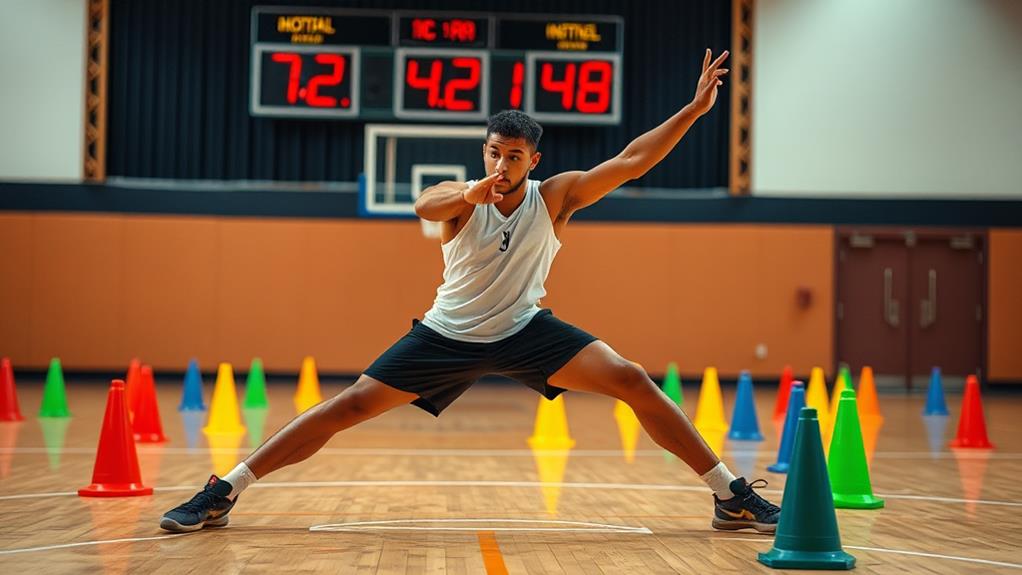
Essential Stretches for Basketball Players to Prevent Injuries
October 5, 2024Essential stretches for basketball players are vital to preventing injuries and boosting performance. Start with dynamic stretches like walking lunges and butt kickers to warm up. After practice, incorporate static stretches such as standing hamstring and quad stretches to aid recovery. Pay special attention to your lower body with hip flexor and calf stretches for ideal flexibility. Don't overlook your upper body; shoulder and upper back stretches can enhance shooting mechanics. Regularly practicing these stretches—about 3-5 times a week—helps maintain your range of motion and reduces injury risk. There's so much more to discover about effective stretching routines tailored for basketball!
Importance of Stretching
Recognizing the importance of stretching can greatly enhance your performance on the basketball court. A proper stretching routine not only improves your flexibility but also increases your range of motion, which is essential when executing those complex movements during the game.
By incorporating both dynamic stretches before your practice and static stretching afterward, you can effectively prepare your muscles for action and promote recovery. Additionally, effective conditioning methods for athletes highlight the significance of stretching in injury prevention and overall performance enhancement.
Regular stretching helps prevent injury by ensuring your muscles aren't only warm but also properly aligned and ready for the demands of the sport. Stretching increases blood flow, aiding in faster recovery and minimizing muscle soreness after intense workouts.
Aim to stretch 3-5 times a week to achieve ideal flexibility; this consistency is critical for maintaining your athletic performance throughout the season.
After a game, static stretching helps reset muscle length, essential for ideal muscle function. By making stretching a priority, you can enhance your overall game and keep yourself injury-free.
Dynamic Stretching Techniques
When you're warming up for a game, incorporating dynamic stretching techniques like Walking Lunges and Butt Kickers can really boost your performance.
These exercises not only enhance your flexibility and range of motion but also prepare your muscles for the explosive movements you'll need on the court.
Additionally, pre-game cardio routines are essential for optimizing your game readiness and preventing injuries.
Let's explore some key dynamic exercises and their benefits to keep you agile and injury-free.
Key Dynamic Exercises
Dynamic stretching techniques play an important role in preparing basketball players for the physical demands of the game. Incorporating exercises like Walking High Knees and Butt Kickers gets your blood flowing and readies your lower body for explosive movements.
One essential dynamic stretch is the Forward Lunge with Rotation, which effectively targets your hip flexors and enhances knee stability, helping to prevent injuries during lateral movements.
Don't forget to include Knee Hugs and Straight Leg Kicks in your routine; these exercises activate the glutes and hamstrings while improving flexibility and coordination. This can considerably reduce the risk of strains and tears while you play.
Additionally, performing Side Lunges stretches your groin and abductors, which are critical for lateral agility and overall defensive readiness on the court.
Each dynamic exercise should be executed for 30 seconds to guarantee a proper warm-up and ideal muscle activation before diving into high-intensity activities.
Incorporating these key dynamic exercises into your pre-game routine can make a world of difference in your performance and help keep you injury-free throughout the season.
Benefits of Dynamic Stretching
Incorporating dynamic stretching into your warm-up routine offers numerous benefits that can markedly enhance your performance on the basketball court. Dynamic stretching increases blood flow and oxygen levels in your muscles, preparing your body for the high-intensity activities that basketball demands. By engaging in these stretches, you'll improve flexibility and range of motion, which are vital for executing explosive movements like jumping and sprinting.
Dynamic stretching techniques, such as walking lunges or high knees, allow you to activate multiple muscle groups simultaneously. This effective warm-up method not only enhances your athletic performance but also plays a significant role in injury prevention. When you perform dynamic stretches immediately before practices or games, you reduce the risk of muscle strains and other injuries that can sideline you.
Research shows that athletes who incorporate dynamic stretching routines experience improved agility and quicker reaction times, essential attributes for success in competitive basketball environments.
Static Stretching Techniques

Now that you've warmed up with dynamic stretching, it's time to focus on static stretching techniques.
These stretches can notably boost your flexibility and aid in muscle recovery, especially after intense workouts.
Additionally, incorporating diverse training methods can enhance athletic performance and promote inclusivity in sports.
Let's explore some recommended static stretches that can enhance your performance on the court.
Benefits of Static Stretching
Static stretching offers a multitude of benefits for basketball players, especially when performed after workouts. By holding a stretch for 20-30 seconds, you can effectively lengthen your muscles, leading to improved flexibility. This enhanced flexibility is vital for injury prevention, as it allows your body to withstand the demands of the game without straining.
Incorporating static stretches into your routine not only aids in muscle recovery but also promotes relaxation and reduces muscle tension. After an intense game or practice, taking the time to stretch helps lower your heart rate, body temperature, and blood pressure, facilitating a smooth shift to a resting state.
Regular static stretching, ideally 3-5 times a week, can greatly improve your range of motion. This increased mobility is essential for executing athletic movements safely and effectively on the court.
As you enhance your overall flexibility, you'll find it easier to make those quick cuts, jumps, and pivots that basketball demands. Ultimately, prioritizing static stretching in your regimen is a smart approach to support both your performance and long-term health in the sport.
Recommended Static Stretches
To enhance your flexibility and support your performance on the court, it's important to incorporate specific static stretches into your routine.
Start with the Standing Hamstring Stretch. Stand tall, place one leg in front, and lean forward while keeping your back straight. Hold this position for 20-30 seconds to effectively lengthen your hamstrings.
Next, try the Standing Quad Stretch. While standing, grasp your ankle and pull it toward your glutes, ensuring your knees stay together. This stretch targets the quadriceps, vital for jumping and running.
Don't forget the Butterfly Stretch. Sit on the floor, bring your feet together, and gently lower your knees toward the ground. This stretch focuses on your groin, essential for lateral movements in basketball.
Lower Body Stretches
While basketball demands explosive movements that can strain the lower body, incorporating essential stretches can enhance your flexibility and reduce the risk of injuries.
Start with the Hamstring Stretch to alleviate tightness in the back of your legs, which can hinder your speed. Follow this with the Quadriceps Stretch to keep your thighs flexible, preventing strain during intense gameplay. To further enhance your performance, consider the benefits of lightweight materials used in modern basketball shoes, which can also contribute to better agility and movement.
Next, don't forget Hip Flexor Stretches. Tight hip flexors can limit your mobility and increase injury risk, so make this a regular part of your routine. For better lateral movement, include Adductor Stretches to target your inner thigh muscles, essential for those quick directional changes on the court.
Lastly, incorporate Calf Stretches to improve ankle flexibility. This is important since ankle sprains are common due to the jumping and pivoting involved in basketball.
Additionally, engaging in glute activation stretches can boost your speed and power while providing support for proper alignment and stability in your lower body movements.
Upper Body Stretches

Upper body stretches are fundamental for basketball players looking to enhance their performance and prevent injuries. Focusing on upper body mobility helps improve your shooting mechanics, allowing for better elevation during shots.
Incorporating shoulder stretches into your routine is essential, as they maintain flexibility in your shoulder joints, greatly impacting your passing and shooting efficiency. Regularly practicing these stretches can also support your overall fitness and enhance your mental resilience, which is critical for coping with the pressures of competitive play mental resilience techniques.
Targeted stretches for your upper back can improve posture and flexibility, which aids in maintaining balance and stability on the court. When you stretch regularly, it also increases blood flow to your muscles, promoting recovery and reducing tension after intense gameplay or training sessions.
After games, consider static stretches held for 20-30 seconds to promote muscle relaxation and flexibility. These stretches not only help alleviate tightness but also contribute to overall injury prevention.
Ankle and Foot Mobility
Ankle and foot mobility is essential for basketball players, as it directly impacts your jumping ability and helps prevent ankle sprains during explosive movements.
Improving your ankle mobility enhances flexibility and supports agility on the court, allowing you to move quickly and effectively. Additionally, maintaining proper field dimensions and equipment requirements can help guarantee that players are prepared for the physical demands of the game.
To boost your ankle and foot mobility, consider incorporating the following drills into your routine:
- Front Foot Elevated Ankle Mobility Drill: Perform 8 repetitions on each side to enhance flexibility in the soleus muscle.
- Ankle Mobility Drill: Hold a stretch for 3 seconds and repeat it 8 times on each side to improve overall ankle function.
- Dynamic Ankle Rotations: Use this stretch to increase range of motion and body awareness.
Stretching Routine Frequency

A consistent stretching routine is fundamental for basketball players aiming to enhance performance and reduce injury risk. To achieve ideal results, you should incorporate stretching into your warm-up and cool-down sessions, ideally performing these routines 3-5 times each week.
Start your warm-up with 5-10 minutes of general activity followed by dynamic stretching, as the passion fuels motivation to prepare your muscles for the demands of the game.
After playing, it's vital to cool down gradually. Follow this with static stretching to aid muscle recovery and improve flexibility. Hold each static stretch for 15 to 30 seconds, completing 4 to 10 repetitions for effectiveness. This approach not only promotes muscle recovery but also plays a considerable role in injury prevention.
Remember to adjust your stretching routine frequency and intensity based on your training's specific demands and how your body responds.
Listening to your body will help you fine-tune your approach, ensuring you're always in peak condition. By committing to this structured routine, you'll not only enhance your performance on the court but also greatly reduce the chances of injury.
Benefits of Stretching
Incorporating a regular stretching routine offers numerous benefits that can elevate your basketball performance. By enhancing flexibility and range of motion, stretching directly contributes to improved jumping ability and running speed—both essential for dominating the court.
Additionally, engaging in speed and agility drills can complement your stretching routine, further enhancing your overall athletic performance.
Consider these key advantages:
- Reduced Risk of Injuries: Regular stretching prepares your muscles for the physical demands of the game, lowering the chances of strains and sprains.
- Faster Recovery: Engaging in stretching promotes blood flow to your muscles, helping you recover more quickly and minimizing soreness after intense gameplay.
- Enhanced Performance: Increased body awareness and control through stretching allows you to execute skills with greater effectiveness.
Conclusion
Incorporating essential stretches into your routine can be the difference between soaring to new heights and sidelining yourself with injuries. While it may seem tempting to skip stretching in favor of more thrilling drills, remember that flexibility fuels performance just as much as strength does. By dedicating time to both dynamic and static stretches, you're not just protecting your body—you're enhancing your game. So, stretch wisely and play hard; your future self will thank you.


